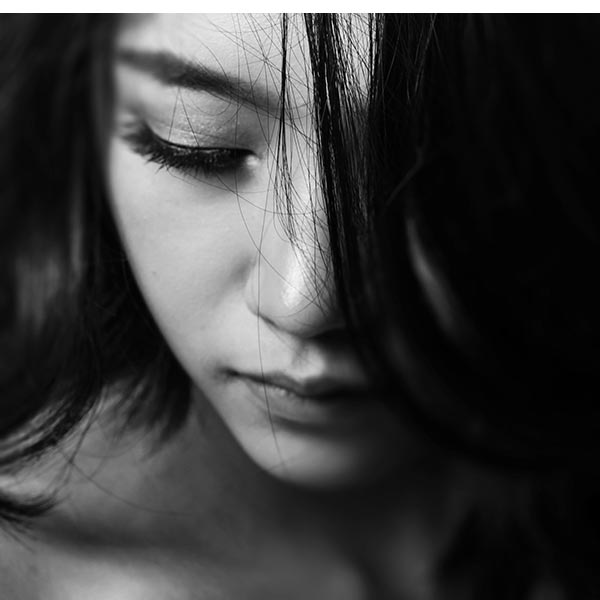Do You Suffer From Female Pattern Hair Loss?
A Functional Medicine Approach To Female Pattern Hair Loss

How To Treat Female Pattern Hair Loss (FPHL) Naturally
Female Pattern Hair Loss (FPHL) is more common than you may realize, affecting more than 55% of all women. Because FPHL can be caused by high androgen levels (testosterone and DHEA), women with Polycystic Ovary Syndrome (PCOS) and other hormone imbalances who also have high androgen levels often experience hair thinning.
Hair loss in women can cause significant psychological distress and feelings of social isolation. There is social acceptance and understanding of this phenomenon in men, but not with women. If you suffer from this condition, you may feel unattractive, depressed, or have low self-esteem.
In conventional medicine, most cases of FPHL respond better to early intervention – because treatment prevents further hair loss rather than stimulating new hair growth. Because the underlying cause of FPHL is not known in most cases, you need to continue standard pharmaceutical (drug) treatment indefinitely to prevent further loss. However, if you identify the underlying cause of your hair loss, treatment can be far more successful, and you may be able to stop medications.
Female Pattern Hair Loss (FPHL) affects more than 55% of all women…
%
Why Am I Losing My Hair?
Here’s the reality: inside your hair follicle, testosterone breaks down into an even stronger androgen known as Dihydrotestosterone (DHT). DHT can bind to receptors sites in your hair follicle – and shrink it or even kill it off! With PCOS and hormone imbalance, you may either have enzymes that are more efficient at creating DHT, or you may just have more sensitive DHT receptors. Either way, the end result is hair loss.
Any factor that increases your androgen levels can cause inflammation that directly injures your hair follicles. This then leads to progressive hair loss.
How Do I Know If I Have FPHL?
One of the hallmarks is the pattern of hair loss on your head. With FPHL you develop widespread thinning over the top of your head, but your hairline in front is preserved. The thinning is most obvious when your hair is parted in the middle and your exposed scalp is visible.
If you have hair loss or shedding that is more global, it may be from another condition such as alopecia areata, medication-induced hair loss, Lupus, thyroid disease, iron deficiency, crash-dieting, starvation or malabsorption issues. Many women have come to see us solely for hair loss, and in our investigation we discover they have PCOS – and hair loss may be their only symptom.
With Female Pattern Hair Loss you develop widespread thinning over the top of your head, but your hairline in front is preserved. The thinning is most obvious when your hair is parted in the middle and your exposed scalp is visible.
Conventional Treatment Options For Female Pattern Hair Loss
Conventional therapy uses medications that reduce the effect of androgen hormones on your hair follicles. This strategy has limited success for several reasons. First, if you are pregnant, breastfeeding or thinking of getting pregnant you must avoid these medications as they can result in birth defects. Secondly, as soon as you stop your medication, your hair loss will immediately return. Third, there is no safety data for long-term use of these medications. These are the common ones:
- Finasteride is meant to reduce prostate growth in older men, but it’s used off label for hair loss in women. There have been case reports of women using Finasteride at doses between 1.25 to 5 mg daily with some success, but large scale studies are needed. Side effects include breast tenderness and reduced libido.
- Cyproterone acetate blocks androgen receptors and can reduce hair thinning in women who use it with the oral contraceptive “Diane 35.” It is not available in the United States. Side effects include irregular bleeding, breast tenderness, depression and loss of libido.
- Spironolactone is another androgen receptor-blocker. It occupies the receptors on your hair follicles to prevent hair follicle shrinkage. Side effects include frequent periods and abnormal bleeding. It has a varied side effect profile because it also acts as a diuretic and can impact your blood pressure and electrolyte levels
- Minoxidil (Rogaine) is the only non-androgen dependent medication that comes in a topical solution to directly apply to your scalp. It is thought to increase your hair’s growth phase. This part of your hair growth cycle may last for 2 to 7 years. 2% and 5% options are used for hair regrowth, however, only 2% is approved for women. Once treatment is stopped, hair loss will resume.
- Birth control pills work by increasing certain binding proteins in your liver that can take androgens out of circulation. It takes about 4 to 6 months to slow hair loss. It is important to note that large amounts of hair loss may occur when you stop birth control pills.
Sound Discouraging?
Get Hope With A Functional Medicine Approach!
In Functional Medicine, we attempt to uncover the underlying cause of symptoms instead of suppressing them with drugs that don’t always work. Hair loss is a perfect example of a chronic, progressive condition that is not adequately treated with medications since they won’t fix the underlying causes.

Hair Loss From Hormone Imbalances & PCOS Can Be Caused By Five Factors
There isn’t “one” hormone imbalance or PCOS diet, or “one” treatment strategy – we must understand the underlying cause(s) in order to figure out what lifestyle, nutrition and supplement support strategies will work best for you. Hair loss from hormone imbalances and PCOS can be caused by five factors. Each lead to excess androgen hormone production:
Inflammation
Long-standing immune system activation can create excess inflammation in your body. Inflammation leads to excess androgen production, insulin resistance, and direct injury to your hair follicles. To investigate whether or not you are inflamed, ask yourself:
- Are you eating foods that you are intolerant to?
- Do you have digestive issues that are unaddressed?
- Are you under a lot of stress?
- Are you exposed to environmental toxins? (Mold, air pollution, unfiltered water, cosmetic and hygiene products with dozens of chemical ingredients, pesticide-coated fruits and vegetables, hair coloring, silver (amalgam) fillings, and smoke exposure are the biggies.)
- Do you suffer from chronic pain, such as arthritis, muscle aches, migraines, neck or back pain?
Action Steps:
- Remove any food that causes any kind of reaction. This can be digestive (bloating, reflux, constipation, abdominal pain), systemic (headaches, runny nose, fatigue, brain fog, sleepiness) or allergic (throat tickle, sneezing, rashes).
- Clean up your toxic exposures with organic food. Start with the dirty dozen list from the Environmental Working Group and swap out the 12 top pesticide coated fruits and vegetables with organic versions.
- Address chronic physical complaints by working with a knowledgeable Functional Medicine provider.
- Our program addresses causes of inflammation, and is a cost-effective step-by-step approach to healing inflammation, hormone imbalances and PCOS.
High Stress Levels and Adrenals
About 50% of women with PCOS have high adrenal androgen levels. Chronic stress raises your cortisol and adrenaline levels, and can also cause high DHEA and androstenedione (adrenal androgens). You may be producing high adrenal androgens with any of these symptoms:
- Fatigue and exhaustion most of the time.
- Feel wired yet tired at bedtime, with difficulty falling or staying asleep.
- Don’t feel rested in the morning despite having 8 hours of sleep.
- Feel exhausted after a workout.
- Need an afternoon nap.
Action Steps:
- Identify the stressors in your life, both external and internal, and address these stressors with the help of a health coach or therapist.
- Create some calm with meditation, even if only 5 minutes a day.
- Measure your adrenal stress hormone function and work with a practitioner to restore adrenal balance.
%
About 50% of women with PCOS have high adrenal androgen levels
Nutrient Deficiencies
You may have vitamin and mineral deficiencies that prevent hair growth: iron, selenium, zinc, vitamins A, C, E, and vitamin B complex. You may unknowingly have low dietary intake of these nutrients, or poor gut absorption related to inflammation or infection in your gut. Lack of key nutrients can cause hair follicles to stay out of active growth cycles. There are too many signs caused by these nutrient deficiencies to list, so go right to the Action Steps »
Action Steps:
- Include more nutrient dense food in your diet – colorful and varied vegetables and fruits, grass-fed organic beef and chicken, wild low-mercury fish, and healthy oil, fats, nuts, and seeds increase the vitamins and minerals you need on a daily base.
- Do nutrient testing to identify deficiencies and correct them.
- Work on gut-healing programs to improve absorption of the nutrients you are eating.
- Address nutrient dense eating, key nutrients to supplement, digestive health, including building beneficial gut bacteria.
Insulin Resistance
High insulin stimulates your ovaries to make more androgens, while also lowering SHBG (sex hormone binding globulin) – a protein that acts like a sponge to sop up excess circulating androgens. How do you know if you have insulin resistance? These signs are tell-tale:
- Waist circumference larger than hips (apple shaped body, or muffin-top).
- Family history of diabetes, obesity, or PCOS.
- Personal history of gestational diabetes
- Your fasting blood sugar has been above 90.
Action Steps:
- Do comprehensive lab tests to figure out your degree of insulin resistance. Work with a practitioner for testing and holistic treatment.
- Ditch the sugar, artificial sweeteners, and “natural” sweeteners like honey, coconut sugar, molasses, stevia, etc. Get rid of processed foods that contain one or more of these ingredients, as well as processed flour (wheat or other) products that are immediately convert into sugar.
- Include adequate healthy fats and protein in each meal, and get rid of excessive starchy carbs and grains. Aim for 30 to 35 grams of fiber a day to slow the entry of sugar into your bloodstream. Studies show that increased fiber intake improves weight loss and reduces sugar intolerance.
Thyroid Issues
25% of women with hormone imbalances and PCOS also have low thyroid function, which by itself can increase your androgens and hair loss. How do you know if you have thyroid issues when the symptoms overlap with female hormone imbalance and PCOS? Besides hair loss and weight gain, low thyroid function symptoms in particular include:
- Feeling cold
- Dry skin
- Depressed mood
- Fatigue
Action Step:
- Absolutely start with comprehensive thyroid function testing
%
25% of women with hormone imbalances and PCOS also have low thyroid function
Conclusion:
It is important to address each and every cause thoroughly in order to stop the progression of your hair loss. For example, treating only insulin resistance with a low-carb diet will not help if you have a lot of inflammation. Or, solving inflammation (or taking anti-inflammatories) will not fix hair loss if your thyroid imbalance isn’t addressed.
You’ll get the best results if you understand which underlying causes are involved in your hair loss, and fix each one of them systematically.
To learn more about what you can do about Female Pattern Hair Loss (FPHL), contact Dr. Sadaty today!
